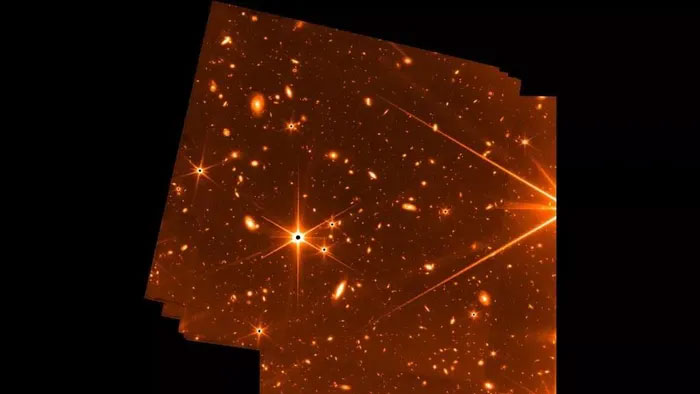Hundreds of distant galaxies seen through the James Webb . telescope
An image just captured by the James Webb telescope's Delicate Guide Sensor provides a fascinating view of distant galaxies in the universe in infrared light. It shows a number of stars and hundreds of galaxies scattered across the distant universe.
This image, released by NASA on July 6, was taken by the James Webb Space Telescope over an eight-day period in May and consists of 72 snapshots taken over 32 hours of exposure.

Hundreds of distant galaxies have been captured by the James Webb telescope
As such, the most powerful and expensive space observatory ever built has finally begun its ambitious scientific work in earnest.
While the near-infrared camera of the James Webb telescope focuses on a star called HD147980. During the test, the FGS kept the telescope pointed at its target. The resulting image, a by-product of this supporting work, shows the universe on a white to red color scale, with whiter shades representing the brightest infrared-emitting objects and the redder shows dimmer objects.
"The faintest blobs in this image are exactly the kind of faint galaxies the telescope has," said Jane Rigby, James Webb telescope control scientist at NASA's Goddard Space Flight Center in Greenbelt, Maryland. James Webb will do research in the first year of scientific activities'.
The mission of this instrument is to enable precise measurements by other instruments by helping the telescope to precisely point at the stars and galaxies of interest to scientists. However, the images hint at groundbreaking discoveries coming from the observatory.
"I was thrilled to see all the detailed structure in these faint galaxies," said Neil Rowlands, FGS program scientist at Honeywell Aerospace, which built the instrument.
While the image may be the deepest image of the universe in infrared light the public has ever seen, its glory won't last long, according to Bill Nelson, NASA Administrator.
The James Webb telescope carries two cameras and two spectrometers and is specifically designed to see infrared light in order to detect some of the most distant (and oldest) galaxies in the universe.
Although these galaxies emit visible light, due to the redshift effect caused by the expansion of the universe, this visible light shifts to longer infrared wavelengths, requiring a telescope. super cold like Webb.
- NASA finished assembling $ 9.7 billion telescope
- James Webb telescope completes final test, set to launch in October
- NASA reversed the time of launching the James Webb space telescope until 2020
- Telescope James Webb will search for alien life
- NASA has postponed the world's most powerful space telescope
- The James Webb Space Telescope will be launched into orbit in October 2018
- NASA hides technology on telescopes looking backwards
- Image of the James Webb telescope seen from Earth
- James Webb telescope prepares to spy on 2 strange 'super-Earths'
- NASA restarted the Hubble telescope replacement project
- Why does the James Webb telescope have to fly 1.5 million km?
- Super telescope looks back 13.5 billion years of failed testing
 Van Allen's belt and evidence that the Apollo 11 mission to the Moon was myth
Van Allen's belt and evidence that the Apollo 11 mission to the Moon was myth The levels of civilization in the universe (Kardashev scale)
The levels of civilization in the universe (Kardashev scale) Today Mars, the sun and the Earth are aligned
Today Mars, the sun and the Earth are aligned The Amazon owner announced a secret plan to build a space base for thousands of people
The Amazon owner announced a secret plan to build a space base for thousands of people China builds world's largest radio telescope
China builds world's largest radio telescope  Admire spectacular images of the universe through the James Webb telescope
Admire spectacular images of the universe through the James Webb telescope  He built the world's largest telescope
He built the world's largest telescope  Hubble Telescope celebrates its 34th birthday with many impressive records
Hubble Telescope celebrates its 34th birthday with many impressive records  SKAO telescope - a solution to help humanity search for extraterrestrial life
SKAO telescope - a solution to help humanity search for extraterrestrial life  Boy builds telescope that can observe the surface of the Moon, with only wires and a few cans of soft drink
Boy builds telescope that can observe the surface of the Moon, with only wires and a few cans of soft drink 